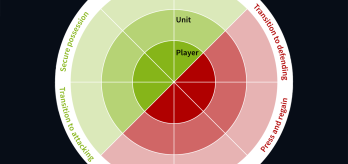In the first part of this two-part series, Professor Cumming explained that young people develop physically at different rates, and that individual differences in the timing of puberty present a challenge to coaches. In this session, he introduces one way of meeting those challenges, in the shape of "bio-banding." Bio-banding sees players grouped together on the basis of their physiological development, rather than their age, and results in a very different training and competition experience for players and coaches. The session is followed by a Q&A, hosted by FIFA's Dr Paul Bradley.
Introduce the concept of bio-banding and explain how it works in practice. Show the potential benefits of bio-banding and suggest how it might be used to manage the load on young players as they develop.
Bio-banding has the potential to bring significant benefits for clubs, players and associations, although more research is still required in this area.
Professor Cumming recommends that clubs and associations consider integrating bio-banding as part of their youth systems and as a complement to age group training and competition.
Watch presentation
Read summary
Part 1: The development of bio-banding
Professor Cumming begins with a summary of how bio-banding has developed. It is not a new idea, but it is only now gaining real traction. The advent of the English Premier League's Elite Player Performance Plan was a watershed moment in this respect, and eventually spawned the first bio-banded tournaments. These competitions grouped youngsters according to their biological age as opposed to their date of birth, and were designed to mitigate the temporary physical disparity between early and late developers.
Part 2: How does bio-banding work?
Having outlined the fundamental principle of bio-banding, Professor Cumming then gives some concrete examples of how bio-banding works in practice. Among other things, he explains the data and methods on which bio-bands are based, how this data can also be used to predict the onset of the adolescent "growth spurt" and better identify early and late developers, and how coaches might approach the task of putting together a bio-banded XI on the basis of the players' physiological development rather than their chronological ages.
Part 3: The benefits of bio-banding and "Futures" squads
Bio-banding appears to be growing in popularity. One reason for this is that it offers a different challenge from age-group football, and tends to lead to a greater focus on technical and tactical ability. As bio-banding has gained traction, it has given rise to the concept of "Futures" XIs: bio-banded U16 teams specifically designed to favour late developers who might be out-muscled in age-group football. The Belgian FA has enjoyed particular success with this model, and other associations are now looking to follow suit.
Part 4: The risks of the growth spurt
When young players hit puberty, they embark on an adolescent growth spurt that leads to profound physiological changes. These changes can lead to a temporary drop in performance and leave players more susceptible to injuries. Here, Professor Cumming revisits his earlier presentation on maturation in young players to highlight some of the issues coaches need to bear in mind when working with players during their growth spurts.
Part 5: Managing the growth spurt
Having highlighted the risks associated with the growth spurt, Professor Cumming concludes his talk by examining some of the strategies available to clubs and coaches to help them manage these risks. One example is AFC Ajax's pioneering "three-phase" training model for young players, which appears to reduce injuries and help players navigate the pubertal growth spurt. The success of that programme inspired other clubs to apply similar principles in their own academies, and initial research suggests they bring significant benefits for players and coaches alike.
Q&A
01:56
If bio-banding is so effective, why don't we just scrap age group competitions?
03:30
How do we accommodate differences in psychological development when playing late-maturing players "up?" or "down" with older or younger peers?
09:06
How do we convince later-developers and their parents that playing "down" an age group is not a step down for their development?
11:21
Where do you see "futures" competition going? Is this something that all national associations should be considering, given the perceived benefits of it?
13:48
We train and develop players more than we play games. What might the benefits of bio-banding be for training?
16:41
How important is it for young players to play with and against players who are not biologically matched to them?
19:22
How are physical, technical and tactical demands modified in bio-banded games as opposed to age group games?
22:52
If you could give a practitioner some simple advice on bio-banding, what would it be?

















